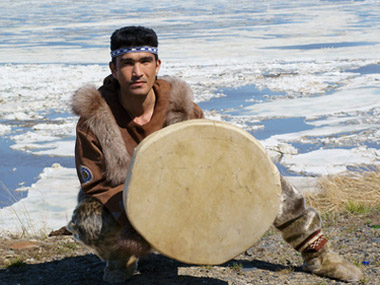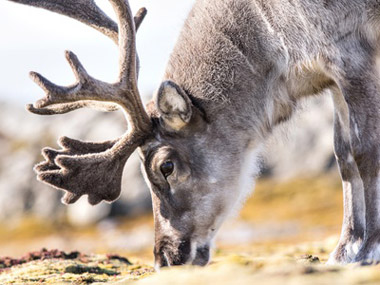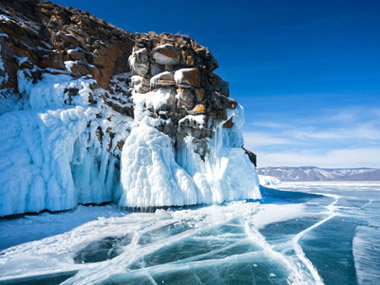 In May 2014 Siberian Federal University became a member of the University of the Arctic (UArctic) with over 170 member institutions and scientific organizations in Russia, Norway, Denmark, Sweden, Finland, the USA, Canada, Greenland, Iceland, and non-Arctic countries. UArctic membership promotes collaboration among UArctic members in norther research via Thematic Networks to enhance northern research and science cooperation, improve opportunities for students to be integrated into framework for development of UArctic education and research which provides an optimal structure for increasing the knowledge generation and sharing across the North by means of educational programmes of the partner universities within the “North2North” Student exchange programme.
In May 2014 Siberian Federal University became a member of the University of the Arctic (UArctic) with over 170 member institutions and scientific organizations in Russia, Norway, Denmark, Sweden, Finland, the USA, Canada, Greenland, Iceland, and non-Arctic countries. UArctic membership promotes collaboration among UArctic members in norther research via Thematic Networks to enhance northern research and science cooperation, improve opportunities for students to be integrated into framework for development of UArctic education and research which provides an optimal structure for increasing the knowledge generation and sharing across the North by means of educational programmes of the partner universities within the “North2North” Student exchange programme.
In 2015 SibFU became a partner of the Russian Geographic Society in the projects “Barneo Expedition” and ‘Duglas’ land lease plane evacuation from Taymyr crash scene”. University faculty and students got an opportunity to visit the Arctic drifting ice station, located a hundred kilometers from the North Pole.



In 2013 SibFU Academic Council under the auspices of the Russian Geographic Society decided to open Department of Geography. Now SibFU and Russian Geographic Society take joint expeditions, including the Extreme North territories.
SibFU endeavours an integrated approach to the Arctic region exploration. Main fields of study:
- Developing means for defence and security, and proper operation of life-support systems:
- Creation of mobile module assembly of Кu/Ka-band to facilitate developing defence and security, ensuring proper operation of life-support systems, and industrial activity in natural climatic conditions of the Arctic zone.
- Research on satellite communication service in Polar regions via spacecrafts in highly elliptical orbits (for example, “Molnia” or “Tundra”) as the only alternative of organizing high quality satellite communication with different objects, including mobile ones.
- Research on integration of satellite, proximal and distal land navigation.
- Research on organization of high quality digital tropospheric scatter in the Arctic and Antarctic Regions.
- Monitoring of the permafrost thaw using shape memory alloys.
- Integrated remote sensing of land by drones.
- Research on pilot volumetric planning and structural solutions for multifunctional buildings and constructions (building materials — including bentwood) in the Arctic and Antarctic.
- Research and development of engineering infrastructure, including wastes recycling.
- Research on spatial filtering using wide-band circular antenna array.
- Development of reflect-array antennas for tropospheric scatter and satellite communication.
- Developing high-technology heat insulation materials and structures.
- Ocean bottom seismic survey on Arctic shelf and mineral exploration, seafloor survey of the Arctic ocean by submersible:
- Developing high-performance hydrocarbon complexes in the Arctic region.
- Mapping of the shelf and deep areas of the Arctic ocean.
- Developing new equipment for underwater communication and navigation.
- Developing automated complex for seismic surveys in water areas.
- Geology, geologic exploration:
- Geological exploration of hydrocarbon deposits.
- Geological survey, mineral search and exploration, minerageny.
- Applied geochemistry, petrology, and mineralogy.
- Mine and underground construction.
- Geological survey for mining enterprises.
- Development and maintenance of mining machinery and equipment.
- Mechanical engineering:
- Developing intelligent drilling control systems.
- Monitoring open-pit mining by drones.
- Developing modular flatbed industrial computer for severe operating conditions.
- Energy Industry and energy efficiency:
- Developing alternative energy sources.
- Distributed and small-scale generation.
- Small free flow hydroelectric station as effective and environmentally safe source of energy.
- Trigeneration systems.
- Effective heating and energy systems in northern settlements.
- Smart energy, northern energy systems.
- Development of nanocomposite UHMWPE-based materials for slip coating in the Far North:
- Creation of UHMWPE-based nanocomposite materials for wide range of applications aimed at development of method for obtaining polymeric nanocomposite materials with the unique physical and mechanical characteristics. Nanocomposites are meant to be used in the Far North (slip coating) and to replace metals in different industrial sectors.
- Social, economic and engineering support of northern regions:
- Working out methodological approaches and state and private partnership models for implementation of strategic tasks in economic development and building of transport and energy infrastructure in northern areas (including the Arctic region), taking into account peculiarities of regions and asymmetry of the social and economic development.
- Working out methodological approaches to formation of principles of horizontal interaction among subjects of the Russian Federation, municipal structures within intergovernmental fiscal relations, and coordination of executive bodies in resource development integrated projects in northern areas, including the Arctic zone.
- Foresight of brand new resource efficient and environmentally safe technologies in the context of green economy approach for the sustainable development of the northern areas, including the Arctic zone.
- Development of methodological proposals for models of comfortable life and working conditions formation in northern areas, including the Arctic region, taking into account peculiarities of areas and asymmetry of the social and economic development.
- Humanitarian aspects, legal support of sustainable territorial development of the North:
- Carrying out a comparative analysis of legislation and strategies of the Russian Federation regions in sustainable development of the Arctic zone land territories.
- Studying the mechanisms ensuring investment attractiveness and sustainable development of the Arctic zone territories.
- Developing recommendations on improvement of legislation of Krasnoyarsk Territory in sustainable development and introduction of the most effective mechanisms.
- Developing the legal support of “green economy” mechanisms application in the Arctic zone.
- Studying the problems of energy efficiency and security in the Arctic region.
- Modern educational technologies, continuous lifetime learning, aiming at development of multicultural education and tolerance in the Russian Federation:
- Establishing the Lifelong Learning Centre in the frame of TEMPUS project at Federal State Autonomous Educational Institution of Higher Professional Education “Siberian Federal University”.
- Building up integrated structures in different levels of professional education.
- Opening of “Centre for Educational Innovations Dissemination”.
- Practice oriented training of lower grade teachers for Krasnoyarsk, Krasnoyarsk Territory and Siberian Federal District within the program of pedagogical education modernization in the Russian Federation.
- Preservation and regeneration of traditional culture of minor indigenous peoples of the North:
- Preservation and actualization of ethnic and cultural heritage of the North.
- Opening of PhD programs on ethnic and cultural studies at SibFU.
- Ecology:
- Comprehensive usage and preservation of water bodies (including norms of allowed exposure), the Pyasina, the Khatanga and the Lower Taymyra river-basins.
- Using of wild reindeer migration monitoring in the Arctic zone of Central Siberia for management of minor ingenious peoples’ traditional activities.
- Getting data for measures on preservation and efficient use of wild reindeer in Evenkiya.
Arctic Exploration in the Krasnoyarsk Territory
In 2014 the Agreement on formation of Arctic Union Regions of Russia which comprised 8 subjects of the Russian Federation including Krasnoyarsk Territory was signed. Additionally the agreement about joint programme of the Northern and Arctic territories exploration between Russian Geographic Society and Krasnoyarsk Territory was signed.
Polar Commission of Krasnoyarsk Territory has been established by the order of the Krasnoyarsk Territory Governor in the frame of 12th Krasnoyarsk Economic Forum.
Exploration and development of the Arctic has been one of the key areas of Krasnoyarsk territory development as the Arctic zone makes up a considerable part of the territory. The Arctic zone occupies about 3.1 million square kilometres. The Russian Federation continental shelf in the Arctic zone occupies over 4 million square kilometres (i.e. about 70 % of the RF continental shelf). About 80 % of gas, over 90 % of nickel and cobalt, 60 % of copper, 96 % of platinum group elements, and almost 100 % of barite of all minerals in Russia have been extracted in the Arctic zone. The Russian sector presents about one third of the entire Arctic zone, and the contribution of the Russian Arctic to global ecosystem balance maintenance is estimated at 12% which exceeds the joint contribution of all Arctic countries. However, exploration maturity of the territory’s most important mineral deposits and energy sources, hydrocarbons in particular, is extremely insufficient.
40 % of the Krasnoyarsk Territory lies in the Arctic zone. The northernmost continental point is located directly within the Krasnoyarsk Territory. The Russian and international polar aviation started up here. It is the very area where the majority of national profit - generating industries has been operating in severe northern conditions, annually bringing billions of roubles to the national budget. Consequently, the Krasnoyarsk Territory has accumulated more solid and hands-on experience in exploration of these territories than anyone else.
The priority growth areas for the RF Arctic zone are as follows:
- integrated social and economic development of the Arctic zone;
- development of science and technologies;
- information and telecommunication infrastructure development;
- ecological compliance;
- international cooperation in the Arctic;
- building up effective instruments for economic stimulation of business.
| Country | Oil | Natural gas |
|---|---|---|
| Russia | 41 | 70 |
| USA (Alaska) | 28 | 14 |
| Greenland | 18 | 8 |
| Canada | 9 | 4 |
| Norway | 4 | 4 |

 Siberian Federal University
Siberian Federal University 
